The Least Regulated State Claim
An In-Depth AnalysisThe Defining Achievement of the Little Administration
On January 31, 2019, Brad Little held a press conference to sign two new executive orders aimed at reducing state regulatory burdens on Idaho citizens and businesses.
Executive Order 2019-02, the “Red Tape Reduction Act,” requires state agencies with authority to issue administrative rules to identify at least two existing rules to be repealed or significantly simplified for every rule they propose. Executive Order 2019-01, the “Licensing Freedom Act of 2019.” put sunrise and sunset processes for future occupational licensing laws in place.
Little pointed out that Idaho’s administrative code included 736 chapters and 8,278 pages of regulations, and at least 72,000 total restrictions. He said the three most regulated areas in Idaho are economic development with 3,018 pages of regulations are, natural resources, with 1,815 pages of regulations, and health and human services, with 1,666 pages of regulations.
He said, “Excessive regulation at all levels of government can impose high costs on businesses, inhibit job growth, and impede private sector investment. Onerous and outdated regulations in state government present barriers to independence and prosperity for Idahoans. The two executive orders I signed today help simplify Idaho state government and make it more accountable to citizens.”
On 12/4/2019, Governor Brad Little announced that the state cut more than 1,800 pages of regulations in 2019, bringing its total regulatory count down to just 41,000 restrictions to surpass South Dakota in becoming the least-regulated state in the country. The video claims a 95% reduction of "Red Tape." Little posited the benefit to voters of his claimed regulation reduction success, saying, "when we reduce the friction on entrepreneurs and businesses, good-paying jobs follow."
What is the Source Little cites for the Least Regulated State assertion?
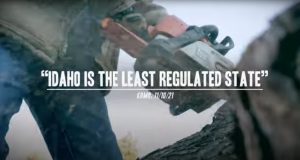
To support the claim, the chainsaw ad from the 2022 primaries cites an 11/10/21 article by KOMO, a television station in Seattle. The KOMO article states, "Idaho is the least regulated state in the nation, a study from George Mason University says." The KOMO article included a quote from Governor Little, which came from his 11/10/21 Press Release. At the bottom of this Press Release, the actual source for his assertion is revealed: "Mercatus data is publicly available at this link: https://www.quantgov.org/regcensus-explorer." For reasons that aren't clear, the Chainsaw Commercial does NOT cite the original source of the Least Regulated State claim in the Chainsaw Ad. In the spirit of transparency, sources should be directly revealed in a citation, so it's clear to the voter that the source is authoritative or opinion.
The bottom line is that Idaho earned the title of Least Regulated State solely based on the extensive research and publicly available data of the Mercatus Center. Founded in 1980, the Mercatus Center is one of over 90 centers at GMU (George Mason University). The Mercatus Center is dedicated to bridging the gap between academic research and public policy problems. Mercatus has become the uncontested Gold Standard for determining Least Regulated State. Their goal is to improve policy-making. Towards that end, they provide ALL the raw regulatory and statutory data for every state, along with the tools and APIs to analyze it. They believe total transparency is the best way to move the needle toward an effective policy that genuinely benefits voters.
How did Idaho Earn the title of Least Regulated State?
In 2012, Patrick McLaughlin of the Mercatus Center set out to answer the question of how you determine the amount of regulation in government and released a working paper that details his deep analysis of the problem and the solution.
In a nutshell, regulations are numbered, but restrictions are not. A single "regulation" contains many restrictions, but they are not numbered. McLaughlin's research of millions of words of regulations showed that restrictions are determined by 5 words: “shall,” “must,” “may not,” “prohibited,” and “required.” These 5 words essentially mark the sentences inside a regulation with the rules and requirements that must be adhered.
As an Idaho Statesman article explains, "According to a study released this fall by the Mercatus Center at George Mason University, the least regulated state is South Dakota with 44,000 restrictions. Of Idaho’s 72,000 restrictions, Little said 30,936, have been eliminated . . . with Idaho cutting more than 40% of its restrictions this year, bringing the number down to about 41,000, Idaho has surpassed South Dakota and is now the least-regulated state in the country." There is no mention of "regulations" in this quote, and now you know why.
How did Idaho earn the coveted, well-publicized title of Least Regulated State title? By reducing the total occurrences of these 5 simple words to be lower than all other states. Without digging deep, you would never know the huge distinction between regulations and restrictions. This nearly invisible but game-changing distinction escaped the attention of almost everyone.
This helps explain how Idaho's total restrictions between 2019 and 2022 were cut by 27.8%, but the total word count was reduced by less than half that - 10.8%.
QuantGov
Created by the Mercatus Center, QuantGov is a free collection of data, tools, and resources for researchers and policymakers in the United States, Canada, UK, and Australia. Federal, state, and local governments produce enormous amounts of policy text, including the text of laws, regulations, trade agreements, treaties, court decisions, and even public speeches. It is almost impossible for any human or team of humans to gain insights from such large bodies of text. For example, it would take the average person over three years to read the entire US Code of Federal Regulations (CFR), which contains more than 100 million words. And that is just the reading component, not comprehension, not quantification, and not analysis.
The 2022 Idaho Regulations contain just under 4M words, which means it would take about a month and a half for the average person to read the entire body of Idaho regulations. It is essential to understand that these are only the regulations coming from the 180 Agencies in our state. It does not include the statutes written by the legislature. That statutory data is also available from QuantGov. For Idaho, that adds another 5.4M words and 95,301 restrictions.
Given the claim that our status of being the least regulated state will "reduce regulatory friction [and] good jobs follow", in the context of over 9M words and 132,000 regulatory and statutory restrictions, what is the material effect of "How Idaho ushered in the largest regulatory cuts in state history"? And how does this help small businesses and entrepreneurs, as Little claimed?
The "Least Regulated State" Study
As you can see, "Least Regulated State" is a general statement that could be open to interpretation. QuantGov was created to make this a data-driven process. The Mercatus Center provides an in-depth analysis of the original 2012 study around the 5 restrictive words, and a more recent 2020 Expert Commentary to shed light on the state rankings used by Little. However states reduced their restriction count, it only matters to the extent it has a meaningful positive impact on the whole point of this exercise - helping the economy.
Per their key comments below, the hard work of the Mercatus Center was and continues to be, focused on policy that moves the needle in that purposeful direction, not moving the needle on political talking points to earn votes or to become a cornerstone of a Business Attraction Campaign to create jobs in Idaho through an outdated, counter-productive, zero-sum game of tax subsidies and incentives designed to attract out-of-state business to Idaho (as explained in another Mercatus Center Study).
Some of the cuts may have been uncontroversial because they were considered low-hanging fruit. For example, Idaho had rules on the books related to a TV game show that was never produced.
Cutting low-hanging fruit makes sense, but future reformers in Idaho and elsewhere should prioritize extending such reviews beyond merely eliminating obviously outdated and unnecessary regulations. Reforms should also include reviewing rules that may sound good in theory but may not achieve their objectives in practice.
Lawmakers can better distinguish beneficial regulations from ineffective and harmful ones by relying more on economic analysis in the review process. This is not a new idea: the federal government has applied a form of cost-benefit analysis to new regulations for decades.
In general, the states lag far behind the federal government in using economic analysis to evaluate their regulations. This is a drawback because it means regulations are unlikely to be evidence-based.
Rankings by State
QuantGov has two main metrics for ranking States - Total number of Restrictions and Word Count. Restrictions, as stated earlier, are the number of instances of the 5 restrictive words: "shall", "must", "may_not", "required," and "prohibited".
Total Restrictions was the metric used to substantiate the claim that Idaho is the least regulated state. However, Idaho ranks 4th in Word Count - 48% more words than South Dakota, which is in Second Place for the Restrictions Count. "Friction" is not just a function of Restriction count. It is also a function of the sheer volume of regulations that must be read.
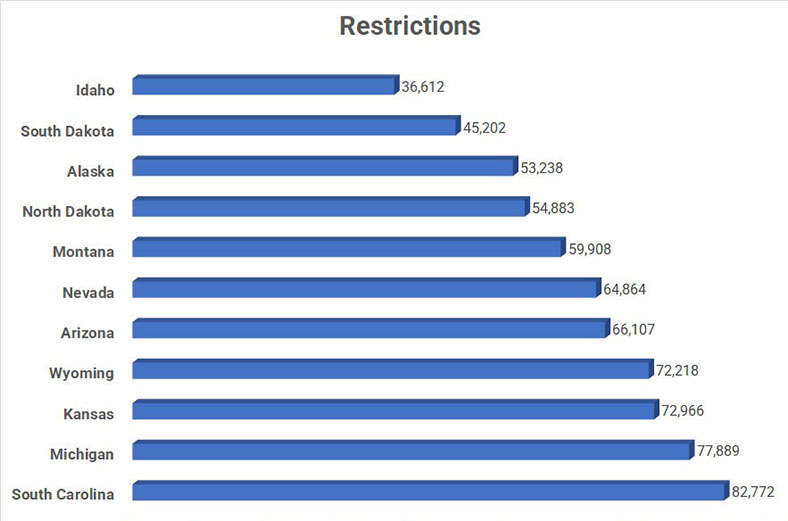
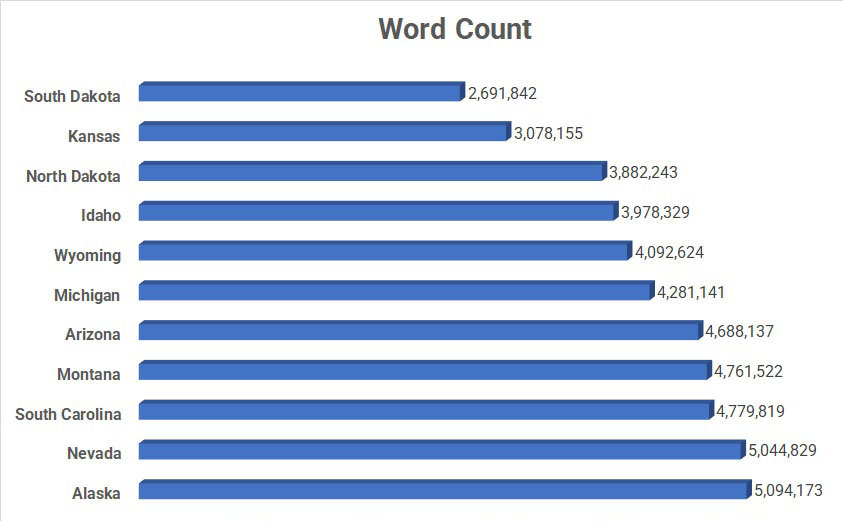
Statutes
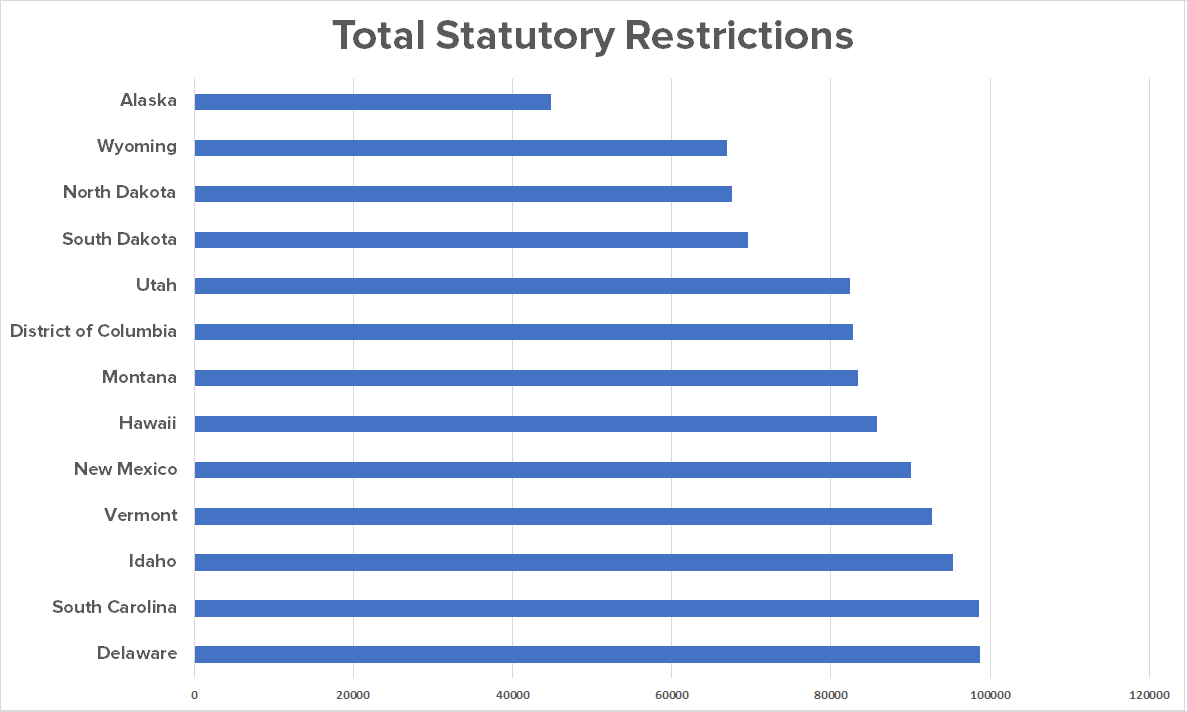
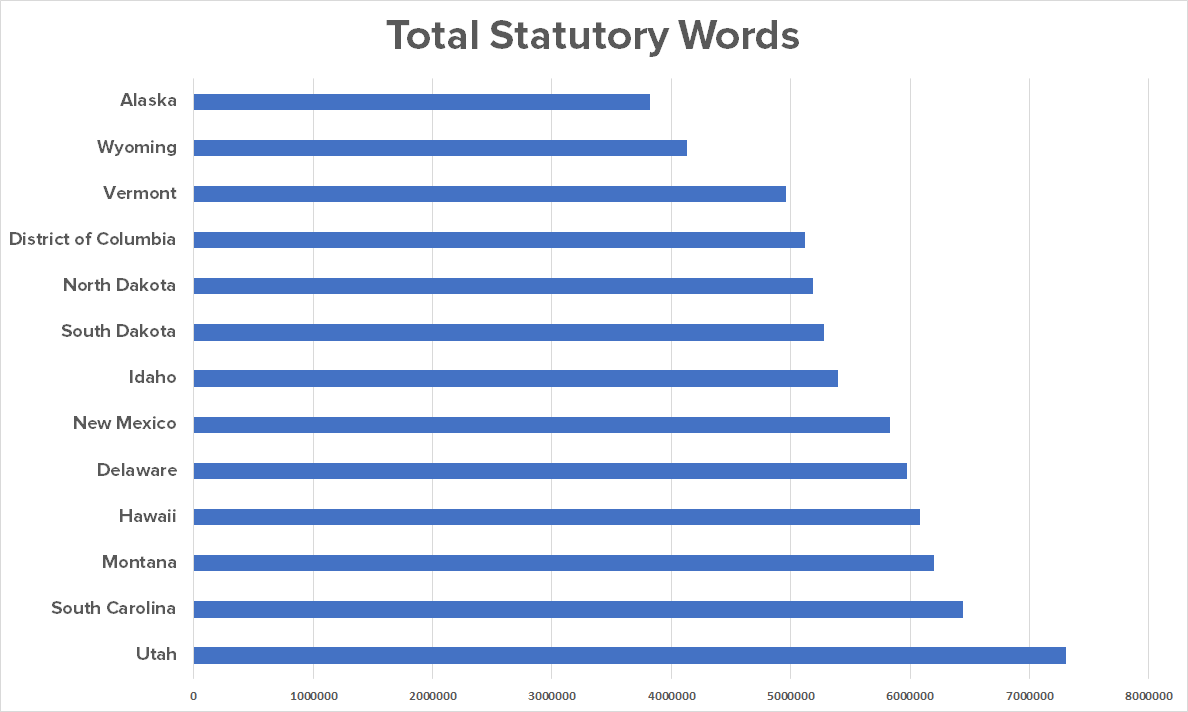
The Actual Total Restrictions = Regulations and Statutes
From a business perspective, compliance is a function of both Agency Regulations and Legislative Statutes. "Friction" is a function of both, not just Regulations.
The functional total for Idaho is 131,913 restrictions in 9,375,500 words when you count regulations AND statutes. This total makes Idaho the 4th Least Regulated State by Total Regulatory and Statutory Restrictions and the 5th Least Regulated State by Word Count in Regulations and Statutes.
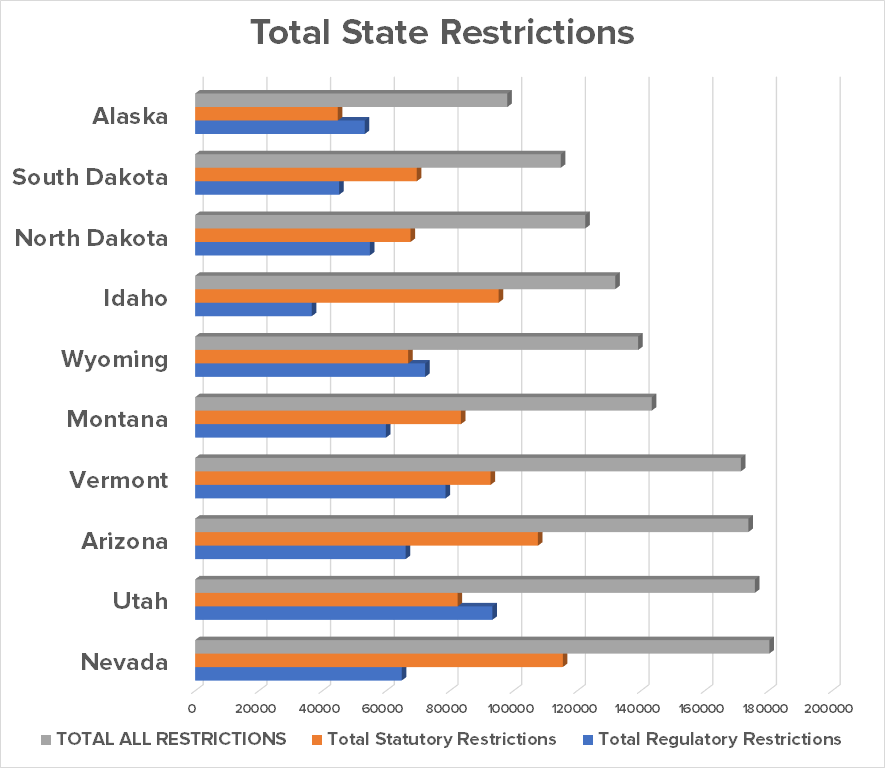

What is the REAL Total Restrictions Count for Agency Regulations?
If you look at the changes from 2019 - 2022, you notice a few things. First, the Total Restrictions were reduced by 14,034 from 50,646 to 36,612 - 27.8%. If you look at the Word Count, that only decreased by 483,213 - 10.8%. Taking this one step further, what was the biggest contributor to this 14,034 decrease of restrictions?
The instances of "shall" decreased by 11,436 from 2019 to 2022 - 46%. This decrease in the instances of "shall" is 81% of the total number of restrictions that were removed from the 2019 regulations to earn Idaho the Least Regulated State title. This leaps off the page.
| Date Collected | Words | shall | must | may_not | required | prohibited | Total Restrictions |
| 7/1/2019 | 4,461,542 | 24,769 | 17,185 | 825 | 7,042 | 825 | 50,646 |
| 4/28/2020 | 4,005,332 | 15,021 | 16,212 | 821 | 6,185 | 722 | 38,961 |
| 5/11/2021 | 4,132,540 | 14,924 | 16,309 | 823 | 6,288 | 733 | 39,077 |
| 3/24/2022 | 3,978,329 | 13,333 | 15,817 | 772 | 5,972 | 718 | 36,612 |
Shall-to-Will Substitution
Merriam-Webster
Definition of Shall
3a—used to express a command or exhortation - you shall go
b—used in laws, regulations, or directives to express what is mandatory - it shall be unlawful to carry firearms
Definition of Will
3—used to express a command, exhortation, or injunction - you will do as I say, at once
If you change the instance of the word "shall" to "will" or "should", or change "shall not" to "may not" or "can not", or change "shall be comprised of" to "is comprised of", you reduce the restrictions count, but the intended restriction - remains. There is no functional difference between Thou Shalt Not Kill and Thou Will Not Kill. It's still a commandment.
This simple shall-to-will word substitution was done over 2700 times - click here to view them.
The true restriction count for Idaho did NOT go down as claimed. Only the scoreboard went down to evade detection by Mercatus, per the guidance provided by the DFM document to the agencies. (see below).
This Shall-to-Will Substitution was also spelled out 5 times on page 41, 50 and 51 of the Idaho Rule Writer's Manual, A Guide for Drafting and Promulgating Administrative Rules in the State of Idaho, Brad Little Governor. Key Point: Was Governor Little Directly involved or did agencies take things into their own hands to creatively comply with his executive order? 1) This document has his name on it, and 2) Its purpose is to promulgate the rules for drafting agency regulations.

The Rule of Law
"The law is a profession of words." By means of words contracts are created, statutes are enacted, and constitutions come into existence.
 As all lawyers know, words matter - a lot. There are two choices in contract law and regulations - remove ALL ambiguity or increase it, depending on your motives. If you want to stay out of court, you make sure a contract leaves absolutely NO ambiguity about the intent of the words. The contract needs to explicitly spell out both parties' obligations or restrictions thereunder, and even restate them with a phrase that starts with "For the purpose of removing all ambiguity . . . . " This also assures that whoever reads the contract cannot fail to see what the restrictions and obligations are. If you want to leave wiggle room, you use imprecise language that can be interpreted either way and stays under the radar when most people read the contract or regulation.
As all lawyers know, words matter - a lot. There are two choices in contract law and regulations - remove ALL ambiguity or increase it, depending on your motives. If you want to stay out of court, you make sure a contract leaves absolutely NO ambiguity about the intent of the words. The contract needs to explicitly spell out both parties' obligations or restrictions thereunder, and even restate them with a phrase that starts with "For the purpose of removing all ambiguity . . . . " This also assures that whoever reads the contract cannot fail to see what the restrictions and obligations are. If you want to leave wiggle room, you use imprecise language that can be interpreted either way and stays under the radar when most people read the contract or regulation.
Changing restrictive keywords doesn't just decrease the restrictions count. It INCREASES ambiguity. For example, Thou Should Not Kill might sound like a suggestion. Consider these two examples from the Red Tape Reduction efforts.
"assignor and its surety shall continue to be responsible for performance of any and all obligations under the lease" versus "assignor and its surety continue to be responsible for performance of any and all obligations under the lease"
The restriction remains when you remove the word shall, but ambiguity creeps in. The agency's intent with this sentence is that it is a restriction. If the intent was to remove the restriction, the words needed to be removed.
A more problematic substitution is below
"The applicant must provide a current written statement from the local or area health district" versus "The Department may require the provider to obtain a statement from the local or area health district"
The word "may" is NOT ambiguous - it allows the restriction to go either way. No business can afford to be at the whim of an agency's decision to enforce this requirement.
Ambiguity in the context of a contract is defined as “whether a reasonably intelligent person looking at the contract objectively could interpret the language in more than one way.” Poorly written contracts end up in court to determine the original intent of the words in a contract. In the case of an agency regulation, an unelected official makes the determination without due process, unless a business wants to go to court.
Mercatus chose the 5 restrictive words because they remove all ambiguity when they're present. They did not make this determination unilaterally. Their extensive text analysis tools looked for patterns, and these restrictive words are used in the millions of words of regulations to remove ambiguity. This is why 3b of the definition of shall states the obvious - it is used in laws and regulations to remove all ambiguity.
What is the REAL Consequence?
Ambiguity and obscurity in contracts and regulations create unmeasurable risks. Businesses must mitigate risk. Therefore, when it comes to State regulations, they must err on the side of caution. They must interpret the 1000's of changed sentences as equivalent to the previous versions that contained any of the 5 restrictive words. They cannot afford battles with any of the 180 agencies in Idaho.
 This might seem easy, but here's the issue. Previously, for a business to identify the restrictions in the pages of Rules or Regulations, they only needed to do a CTR F and use the "Find" function to locate instances of 5 restrictive keywords. That lets them easily isolate/highlight the restrictions. Tools like FileSeek will do that automatically providing each sentence that contains the keyword (from 100's of files). With the restrictive words removed, how does a business search for restrictions? They can't. Thus, they need to read the regulation in painstaking fashion and highlight sentences to identify restrictions that a restrictive keyword would have otherwise flagged.
This might seem easy, but here's the issue. Previously, for a business to identify the restrictions in the pages of Rules or Regulations, they only needed to do a CTR F and use the "Find" function to locate instances of 5 restrictive keywords. That lets them easily isolate/highlight the restrictions. Tools like FileSeek will do that automatically providing each sentence that contains the keyword (from 100's of files). With the restrictive words removed, how does a business search for restrictions? They can't. Thus, they need to read the regulation in painstaking fashion and highlight sentences to identify restrictions that a restrictive keyword would have otherwise flagged.
The exercise our agencies were directed to perform to simplify our 4M words of regulations added complexity, not simplicity. They added FRICTION, they did not reduce it. They created more friction than existed before or would exist with even more restrictions. States with more restrictions, but higher clarity and transparency, are the ones that are easier to do business with. States like South Dakota, Kansas, and North Dakota have more restrictive words but a lower word count than Idaho. They have less friction than Idaho, even if their restriction count is higher.
Case in point, compare the Idaho Statutes with the Regulations. - 26.2% more words but 61.6% more restrictions. Most notable is that the majority of those restrictions come from the word Shall. This is the broader pattern Mercatus discovered in their research, and it fits 3b of the dictionary definition of shall. The lawyers who wrote those statutes were not concerned with titles and scoreboards. Their job was to remove ambiguity (per their training), and that's how they did it. The word density percentages below reflect this. Most notable is "shall" which has a Statute density that is 5X higher than the Regulations density.
| words | shall | must | may_not | required | prohibited | restrictions | |
| Statutes | 5,396,571 | 80,1201.5% | 5,596 | 1,086 | 7,743 | 756 | 95,3011.8% |
| Regulations | 3,978,329 | 13,3330.3% | 15,817 | 772 | 5,972 | 718 | 36,6120.9% |
What did the Mercatus Center say about this?
When this exploitable vulnerability was pointed out to Mercatus, their response was, "[we have] seen the shall-to-will substitution take place." They continued, explaining that "Usually, if that is happening in a state where reg reform is ongoing, it gets noticed eventually by those in charge . . . As for it affecting count accuracy for data purposes—yes, it probably does. But otoh including “will” as a stand-alone restriction will lead to many, many false positives. So, we’ve never made it part of the official count. With our relatively new release of RegHub.ai, however, it is easier for anyone to download the machine readable regs and run their own algorithms on it."
The original Mercatus research 10 years ago was to provide data for better policymaking. They did not define the 5 restrictive words to use. They researched a huge number of regulations and statutes and looked for patterns and frequency with sophisticated text and word analysis tools. From that research, the 5 restrictive words emerged as having a statistically high correspondence to restrictions. Ten years ago, these 5 words were an accurate measure of restrictions in regulations.
The issue is, and Mercatus is aware of it, once you have this standard, it is subject manipulation. The system depends on best intentions to improve policy, and reduce red tape.
What does the New Mercatus Data Show about
"How Idaho ushered in the largest regulatory cuts in state history"?
Regulations on State websites are not easy to find. There is no single master index with links to each regulation. Even if you had that index, performing text analysis on the .pdfs is a massive task. Mercatus developed this capability in 2012 and has been publishing the final numbers. That summary data is the basis of the above table and charts.
The machine-readable files were released in September 2022. Per the Mercatus quote above, it was done to enable policymakers to perform their own text analysis on the data. This was not possible before. Before September of last year (before the election), it was not possible to generate the data published on this site to show how Idaho earned the Least Regulated State title and how Little achieved "historic" reductions.
We took Mercatus's suggestion and designed text analysis algorithms to analyze the 2018-2022 data specifically for restrictive word substitutions and deletions. While it's simple to find all the instance of the restrictive words in the 2018 text files, it is arduous to manually extract the sentence or phrase around it and find it in its modified form in the 2022 text files. Using the Levenstein distance string metric and fuzzy string matching, we designed a program capable of analyzing the millions of words in the regulations to find the restrictive word substitutions (or deletions). We refined it with additional validation methods that effectively remove false positives so the more sophisticated changes made to the restrictions could be found.
The program outputs the results to a spreadsheet with the following information: the original version of the restriction, the new version, agency name, regulation code, title and department, and the Mercatus document_ids for the machine-readable text files. Below is a tiny sample of just the "strings" without all the additional data provided by the tool for each match.
The program revealed there were far more than simple shall-to-will substitutions. Below are examples for all 5 restrictive words. CLICK HERE to view 12000+ instances.
| Original Regulation string containing the Restrictive Word | 2022 Regulation Version of same string without the Restrictive Word | Title of Regulation |
| The lessee shall pay, when due, all taxes and assessments of any kind lawfully assessed and levied against the lessee's | The lessee pays, when due, all taxes and assessments of any kind lawfully assessed and levied against the lessee's | 20.03.16-Rules Governing Oil and Gas Leasing on Idaho State Lands |
| The HHA must inform a patient orally and in writing of any changes in these charges as soon as | The HHA informs a patient orally and in writing of any changes in these charges as soon as | 16.03.07 - Home Health Agencies |
| processed steelhead or anadromous salmon via boat. Jack salmon may not be processed while in the field or in transit. | processed steelhead or anadromous salmon via boat. No jack salmon may be processed while in the field or in transit. | 13.01.11 - Rules Governing Fish |
| Compliance with other specific terms and conditions as may be required by the executive director. | Compliance with other specific terms and conditions as may be directed by the executive director. | 24.34.01 - Rules of the Idaho Board of Nursing |
| each depredation hunt received by June 30 in random order. All applications received after June 30 shall be placed at | each depredation hunt received by June 30 in random order. All applications received after June 30 will be placed at | 13.01.08 - Rules Governing Taking of Big Game Animals |
| receipt of the hearing officer's decision or no attorney fees and costs must be awarded. Objections to the award of | receipt of the hearing officer's decision or no attorney fees and costs may be awarded. Objections to the award of | 15.04.01 - Rules of the Division of Human Resources and |
| restrictions on hunting or access or other good cause that prohibited or limited the outfitter's ability to seek and | restrictions on hunting or access, or other good cause that prevented or limited the outfitting operation's ability to | 24.35.01 - Rules of the Idaho Outfitters and Guides Licensing Boardd |
| assignor and its surety shall continue to be responsible for performance of any and all obligations under the lease until | assignor and its surety continue to be responsible for performance of any and all obligations under the lease until such | 20.03.15 - Rules Governing Geothermal Leasing on Idaho State Lands |
| 06. Obedience to Traffic Direction Required. No person may willfully fail or refuse to comply with any lawful order or directions of any park employee | 06. Obedience to Traffic Direction. No person may willfully fail or refuse to comply with any lawful order or directions of any park employee | 26.01.20 - Rules Governing the Administration of Park and Recreation Areas and Facilities |
| Any person whose name was drawn on a controlled hunt for moose may not apply for a moose | Any person whose name was drawn on a controlled hunt for moose is not eligible to apply for a | 13.01.08 - Rules Governing Taking of Big Game Animals |
| principal business must pay sales or use tax on the purchase of equipment and supplies used to produce display signs, | principal business pay sales or use tax on the purchase of equipment and supplies used to produce display signs, | 35.01.02 - Idaho Sales and Use Tax Administrative Rules |
| The use of dogs for hunting wildlife is prohibited, except for the following wildlife under the following conditions: | No person may use dogs for taking wildlife, except for the following wildlife under the following conditions: | 13.01.15 - Rules Governing the Use of Dogs |
What might Trump say after seeing this new data?

Vice President Mike Pence listens as Idaho Governor Brad Little ,R-Idaho, speaks at the White House in Washington, DC, on July 16, 2020, during an event on Rolling Back Regulations to Help All Americans.
On December 4, 2019, Little announced that, "Trump Administration looks to Idaho on achieving regulatory reform." Little went on to say that "President Donald Trump has taken on regulatory reform to reduce and streamline federal regulations, an initiative led by Vice President Mike Pence. The White House is turning to the states for ways to achieve reform, and Idaho is being held up as the shining example of how to get it done."
On December 16, 2019, it was announced that, President Trump, Vice President Pence meet with Governor Little on regulatory reform. Little proudly proclaimed that, We rewrote our regulations so that they are less burdensome for small businesses and easier for the average Idahoan to understand. I am proud that Idaho is leading in the area of regulatory reform" and he suggested that Idaho was "providing a template for other states and the federal government to follow.”
And in an opinion piece on September 23, 2020, entitled "Together, Idaho and President Trump are taking action to support small business" Brad Little said, "We’ve been working with President Trump and his administration to put people over paperwork by reducing the volume and cost of regulation. . . . We became the least regulated state in the nation last year when we cut and simplified 75-percent of regulations in a matter of months. . . I was pleased to join President Trump and Vice President Mike Pence at the White House this summer to continue our shared push for regulatory reform to support small businesses."
As mentioned earlier, it is entirely unclear how the changes made it easier for small businesses to maneuver the already complicated field of regulations, nor how the changed regulations had applicability to the average small business. This is especially relevant to the voters of Idaho because 99.2 percent of Idaho businesses are classified as Small Businesses (under 500 employees), and 97.6 of ALL Idaho small businesses are 0-19 employees according to the SBA - a whopping 179,612.
Given the data revealed by the text analysis program, it is clear that Little's regulatory "reform" did not help Big Businesses since it makes restrictions even harder to find in the 4M words that comprise that data set.
One wonders what President Trump and Vice President Pence would now think of Little's "shining example of how to get it done", and Little's template to accomplish that, given what the newly released Mercatus data reveals after in-depth text analysis. One also wonders what Trump's OMB Acting Director Russ Vought, Trump's Assistant to the President for Strategic Initiatives Brooke Rollins, Idaho's Senate President Pro Tem Brent Hill, and House Speaker Scott Bedke have to say now after lauding Governor Little for his achievement in the Press Release linked above.
What might Little say after seeing this new data?
In this video from January 30, 2022, Little describes the crowning achievement of his administration. He stumbles out of the starting gate, saying he "cut" regulations, corrects himself by saying they "simplified" 75% of all rules, but later goes back to saying they cut regulations. We showed above what "simplified" means to him. He then uses the word "rules," which means regulations. As the Little quote from 2019 shows at the top of this page, he knows there is a difference between regulations and restrictions, and the documents referenced below also have his name on them.
The Rule/Regulations count is not what matters, but that is not the takeaway from this video. As explained above, rules/regulations contain many restrictions, and only restrictions determine the Least Regulated State. Little is either confused or intentionally misleading voters. Either way, since the buck stops with him, it is his fiduciary duty to understand the basis of the claim he uses to define his governorship and to represent our state to the then President.
We learn in this video that there is one person in charge of regulations at every agency. He speaks to how this avoids finger-pointing on who to talk to. He is representing this to mean a higher level of checks and balances to ensure the right thing is done. Having streamlined the oversight process, the person(s) in charge should have been the one(s) curious enough to ask them how they achieved "historic" Red Tape Reduction before promoting Idaho as the shining example of how to do it in the Federal Government and other States. If for no other reason than to praise the agencies for their outstanding achievement carrying out Executive Order 2019-02 , this question should have been asked.
The Allure of Lower Regulation
Why Corporations Are Drawn to States with Less Red TapeUnderstanding Regulatory Costs
The Financial Strain of Compliance
Operational Costs vs. Compliance Risks
The Bottom Line: The Advantage of Fewer Regulations
Advertising Lower Regulations: A Competitive Edge for States
The Link to Idaho Job Creation
Conclusion
The High Stakes of State Misrepresentation
Legal and Reputational Pitfalls AwaitMisrepresentation and its Consequences
States may be tempted to present themselves as having a lighter regulatory environment to attract businesses, but knowingly exaggerating or falsely advertising such claims can have severe consequences. Not only does this damage the state's credibility, but it can also expose it to legal action.
When a corporation decides to expand or relocate, the decision often involves significant financial commitment, strategic shifts, and even potential risks. If a company makes such a momentous decision based on the state's misrepresentation about its regulatory landscape, and later discovers the truth, they may experience unexpected compliance costs, operational disruptions, and strategic setbacks. This mismatch between expectation and reality can be detrimental, leading to increased expenses and missed opportunities.
Legal Repercussions and Damages
Given the financial stakes involved, it's highly probable that corporations would seek legal recourse. Misrepresentation, especially when done knowingly, can be grounds for legal actions. A corporation can argue that it made substantial investments based on the information provided by the state. If this information was deliberately misleading, the state could be liable for damages. These damages could cover not only the direct costs associated with unexpected compliance but also the opportunity costs of lost alternative investments or expansions the corporation could have pursued.
Additionally, the misrepresentation could also attract class-action lawsuits, especially if multiple businesses were misled. Such collective legal actions could amplify the financial repercussions for the state.
Beyond Financial Costs: Reputational Damage
Conclusion
The Question of Intentionality
Division of Financial Management (DFM)As the data came in from the Text Analysis tool, the question of intentionality emerged. It soon became clear that there was considerable human intervention and thought behind the reduction in restrictive words. There was more than the global search-and-replace done with the 2700 shall-to-will substitutions. There was intentionality.
Here's what came from searching for an answer to that question. Prospective-Analysis-Guide-May-2020.pdf (idaho.gov). The Division of Financial Management issued the marching orders and template.
The Division of Financial Management (DFM) is part of the Governor's Executive Office. Its primary function is to assist the Governor in his duties as the Chief Budget Officer of the State. It is also tasked with working with the rest of the state government to provide fiscal and policy guidance, oversight, and management services on behalf of the Governor.
At the top of the Regulatory Analysis Guide, it says: The guide attempts to answer many of the questions that agencies may have when completing the Prospective Analysis form outlined in Executive Order 2020-01.
At the end it says:
The agencies were given the roadmap to accomplish their marching orders under Executive Order 2020-01.
The specific task this Agency Guide specifies is to fill out the Prospective Analysis form outlined in Executive Order 2020-01. If you look at the end of this form, you'll find metrics for success or failure. 
There is zero ambiguity in this guide. The Executive Order to the agencies? Reduce Red Tape. The metrics? Total Word Count and Restrictive Word Count (exactly what Mercatus tracks - per above).
Net Change in Total Word Count lower? GOOD. Net Change in Total Word Count Higher? BAD.
Net Change in Restrictive Word Count lower? GOOD. Net Change in Restrictive Word Count Higher? BAD.
Anybody can figure this out. Nobody needed to be specifically told what to do or why they were doing it.
Whether agencies were deliberately led to removing restrictive words to earn the Least Regulated Title, without regard for removing actual restrictions, does not matter. Whether the DFM document was intended for this purpose and written with plausible denial does not matter. Common Sense dictates (and so does their Performance Measurement Plan) that simple metrics are what agency employees are measured by. All that mattered was the restrictive word count and the DFM guide spelled that out for the agencies.
Until our leaders follow the advice of Mercatus and use the data shown on this website to be "the ones in charge" that act upon it, correct it, and truly make Idaho the Least Regulated State with less friction, not more, the claim should not be made. It is misleading at best and invalid when an accurate count is done. This claim encourages out-of-state businesses to set up shop in Idaho and create jobs. It is not just misleading voters, it is misleading the corporations that Idaho spends the vast majority of its Economic Development time and budget to attract to Idaho.
The agency responses using this form are supposed to be public record, but as of now, they cannot be found on the website.
 Elected representatives write bills, which, if passed by a legislature, become statutes.These statutes are probably what most people imagine when they think of “law.” Statutes, however, also delegate lawmaking powers to administrative agencies, which then craft regulations. Regulations are laws written by administrative agencies (180 in Idaho). The powers delegated from legislature to regulator can be broad, such that regulating becomes virtually a form of lawmaking all its own.
Elected representatives write bills, which, if passed by a legislature, become statutes.These statutes are probably what most people imagine when they think of “law.” Statutes, however, also delegate lawmaking powers to administrative agencies, which then craft regulations. Regulations are laws written by administrative agencies (180 in Idaho). The powers delegated from legislature to regulator can be broad, such that regulating becomes virtually a form of lawmaking all its own.